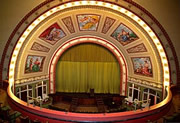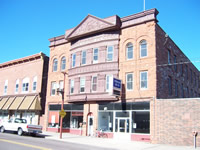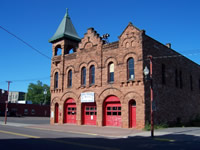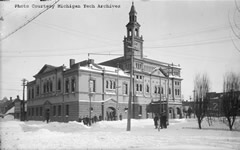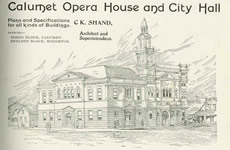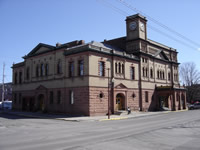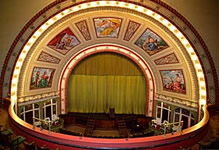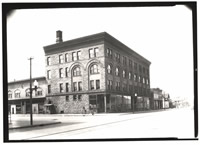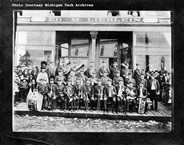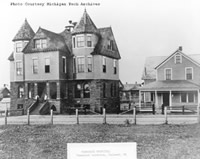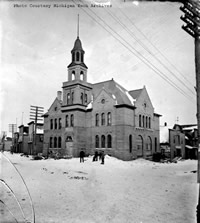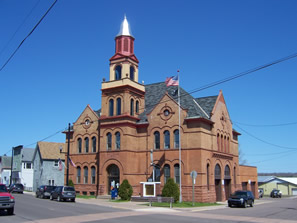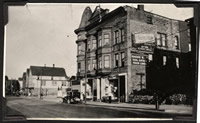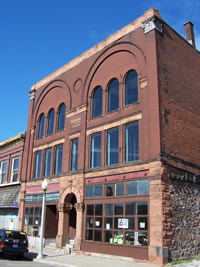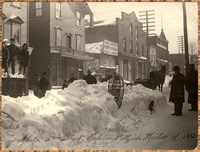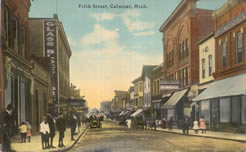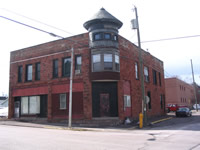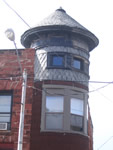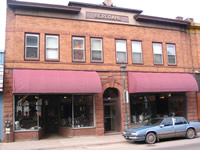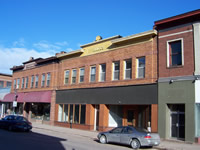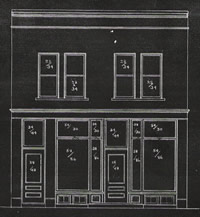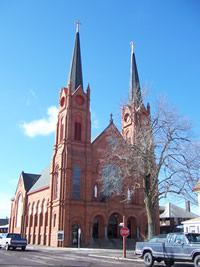Buildings by Charles K. Shand
Edward Ryan Block The Edward Ryan Block, also known as the Duane Girard Building, is a three-story building constructed with sandstone quarried from the Portage Entry. The structure is approximately 75’ x 52’. This building was formerly occupied by the Daily Mining Gazette and the Peninsula Gas Company.9 Two large stores are located at street level, below two levels of flats. This symmetrical building has six bays with the middle four bays protruding from the center of the street façade in a bowed oriel. At the top of the protruding section is a pediment in the parapeted cornice. Subtle, delicate ornament is applied to the Ryan Block. The brown metal cornice has a repeating recessed square pattern creating a slight rhythm which is also present between the levels of the protruding section. Rough-faced coursed ashlar makes up the street façade, interrupted by smooth sandstone belt courses. In addition, smooth sandstone surrounds the arched center doorway and the arched upper windows. In the Copper Country Evening News of 9 June 1898, Shand announced that the Edward Ryan Building will “present a very imposing appearance and will be a credit to that portion of the city in which it is to be erected.”10
Red Jacket Village Fire Hall After a brush fire in 1870 destroyed approximately two-thirds of the Village of Red Jacket, the first fire department was created in 1875. In 1887 the village paid the fire-fighting force, rather than rely on volunteers. Shand was hired at the end of the century when the fire department was further modernized. Procissi & Company was hired to do the stone masonry. The building’s construction cost $20,091.02.11 It housed the fire department until 1964 when it was moved to the Calumet Village Hall. The Red Jacket Fire Hall is still owned by the village and is a firefighting museum. This two-story rectangular building is in the Romanesque Revival style, with round-arched openings in rough-faced Jacobsville sandstone. The Red Jacket Fire Station measured 83-1/2 feet deep and 54 feet wide; the stone of the second story is random ashlar and the first story is coursed ashlar.12 The windows and doors are round-arched. The top of the building has a crow-stepped central gable, with a bell tower in the southeast corner and a smaller pointed gable on the northeast corner. Each of the three project slightly from the building. The first floor of the Red Jacket Fire Hall housed fire-fighting apparatus and horses. The main floor housed the vehicles and horses, while the second floor was composed of space for the supply of hay and feed for the horses, a twelve-bed sleeping apartment, bathroom, reading room, large recreation room, and marshall’s office.13 In 1910, the Red Jacket Fire Hall housed two steam fire engines, one hose cart, one hook and ladder cart, and eighteen firefighters.14 When the building was completed, the Copper Country Evening News enthused: “Visitors to the new fire engine hall are unanimous in stating that it is the finest thing of its sort in the state…not only is the building fitted up in elaborate style, but the idea of making it an ideal fire engine house with respect to the perfect working of the fire fighting apparatus has been uppermost in arranging the interior of the building.”15 Calumet Opera House and Village Hall Addition (Calumet Theatre) Calumet, located in the heart of the copper mining industry, experienced rapid population growth and built a village hall in 1886, designed by J. B. Sweatt. In 1898 the village decided to add an opera house to the village hall, at a cost of approximately $70,000.17 Shand was selected as the architect for this addition. The opera house, which seated 1,200, welcomed many great performers, such as John Philip Sousa and Sarah Bernhardt. However, with the invention of motion pictures and the decline in the copper-mining industry, the opera house was used more for movies than for stage productions. In recent years, it has accommodated a variety of music, theater, and film. The large municipal theater has undergone interior renovations and has been restored to its original colors. In 1999, the proscenium murals were restored. When Shand was awarded the contract for the Calumet Opera House, the attached village hall (the building on the north side) had to be remodeled as well to match the architectural style of the opera house. Together, the buildings are in an Italian Renaissance style. The first floor, of Jacobsville sandstone, is rusticated. The second floor is a cream-colored brick, with round-arched windows paired and tripled. A clock tower marks the transition between the two buildings. The village hall has a pedimented entrance in the center of its 6th St. frontage. The opera house, taller than the village hall, has a porte-cochère topped by a balustrade and, above it, a pediment at the cornice. In the Copper Country Evening News, 2 October 1899, Shand described the opera house in the following statement: “The cornice will all be of copper and the top of the tower will all be of copper, so that in the copper and sandstone, copper country products form a conspicuous part of the building.” The interior of the opera house, by William Eckart of Chicago, is awe-inspiring with intricate ornament, such as the thin layer of gold ornament that is located around the proscenium.18 The stage was approximately 60’ x 28’ x 60’, with the dressing rooms located below. At stage productions, the main floor and balcony were reserved for the upper echelon of society. In the second gallery, the working class took seats upon benches. Furthermore, there were four box seats reserved for the wealthy.19 The Elm Street side of the village hall was altered in 1964 to accommodate the fire station.
Bollman Block Although this business block was initially designed for four separate stores on the first floor, the entire floor was originally occupied by the Lieblein wholesale firm, based in Hancock. In later years, it was home to the Michigan Auto Company. The building was destroyed in a catastrophic fire on March 3, 1950. Joseph Miglio was killed and Charlie Ryan, Sr., lost his leg when they were crushed by a large portion of the front wall that collapsed into Oak Street as they were fighting the fire.21 The four-story masonry building ran roughly 120 feet along Oak Street and 45 feet along 8th. The façade was clad in coursed, rusticated sandstone and topped with an overhanging cornice. Plate-glass storefronts with recessed entrances opened up the first floor. The second and third stories were united in tall round arches, with spandrel panels between floors. At the second story the windows were paired within these arches; at the third level were three windows with double-hung sash. Paired windows surmounted the arches at the fourth level. The second and third floors were divided into apartments and the fourth floor was used as a lodge hall and club rooms.
Tamarack Hospital The Tamarack Hospital was hailed as a “model hospital” when it was constructed, although in appearance it resembled a Queen Anne Revival mansion.22 The walls of the 60-foot-square two-and-a-half-story building were sandstone on the first floor and frame above, sided with narrow clapboards. The gable roof was punctured by symmetrical three-story towers on the front, flanking a gabled projection. The basement contained a drive-in area for ambulances, a freight elevator on which to take patients upstairs, a drug store, and kitchen. The first floor included a 20’ x 30’ reception hall, laboratory, four doctors’ offices, and dispensary. The second-floor front was intended to have a large porch enclosed with movable glass windows for convalescents, but it is uncertain if this were built because the historic photograph does not show it. The second floor had three large wards, one private one, and the operating room. In the attic were bedrooms for dispensing clerks or other employees. The interior was finished with quarter-sawn Georgia pine and adamant plaster and the floor-to-ceiling heights were 12 feet.23 The modernity of the hospital apparently rested with its heating system, which was steam-heated hot air, and which promised constant air turnover. “The structure will be heated by steam, but it will be by the indirect method and not the mode generally employed in the copper country. Instead of having coils in each separate roof [room] in the building the steam coils will all be together in the basement. To these coils cold air from without will be admitted and will be heated with contact with the coils. It will then be carried by pipes to each of the rooms to a point about 8 feet above the floor. The warm air naturally arises to the surface. It then rolls along the ceiling and as it becomes cooler and is succeeded by successive waves of hot air it sinks to the floor along which it moves until it reaches an exit level with the floor. By this system the air in the rooms is constantly being renewed by volumes of warm dry air and which has been drawn from without and the stagnant air is removed. The system is incalculably beneficial in a hospital.”24 Lake Linden Village Hall In 1887, a fire came close to destroying the village of Lake Linden, approximately 40 acres, and the business district was greatly affected. As part of the rebuilding, the Village Council decided to build a new village hall and fire station for $15,000. After Shand was awarded the contract for the design, L.F. Ursin, a local contractor, constructed the hall for $18,293. The Lake Linden Village Hall opened in March 1902. It was used for numerous activities such as elections, dances, and social meetings, as well as village government and fire hall. The building still serves as the village hall.25 The Lake Linden Village Hall is a good example of Romanesque Revival architecture. The building was constructed of coursed sandstone on the first floor and brick above. The village hall is a square, two-and-a-half-story building. The street façade is a symmetrical design, with a central tower, flanked by a gabled pavilion on each side. Each pavilion has a group of three arched windows on each level and the two levels are separated by a beltcourse. Smooth sandstone is used around the arched windows. The central tower has an arched entrance with double wooden doors, and the third level is decorated by a cornice, paired arched windows, and corner pilasters. At the top of the tower, there is a cupola with arched openings and a bell-shaped roof. On the south side of the building, there are two large arched doorways that served as the entrance into the fire hall. The Lake Linden Village Hall is topped with a large hipped roof which was originally covered with slate. The first floor of the village hall contains a village office, lounge area and police station. Between the police station on the south side and the fire hall there is a hardwood staircase that leads to the second floor. Wood paneling and plaster is used on the walls. The second floor consists of a village council room, a large hall with a stage and a kitchen at the south end of the building. At the opposite end of the second level are bathrooms and storage space. The second level has high ceilings and the walls are paneled wood wainscoting with plastered walls on top. The wainscoting creates a horizontal pull which is contrasted by the sills and window cornices. Contrasting the whole interior of the village hall are the lighting fixtures throughout the rooms, which are designed in the art deco mode.26
Walz Block Maggie Walz, a Finnish immigrant, was a businesswoman and real estate developer who commissioned this building for herself. Initially a drug store and a candy store occupied the commercial spaces; Walz had her offices in the building and lived upstairs. She owned the building until her death in 1927. Subsequent owners included the Blander family, who lived upstairs and operated an IGA store in one of the commercial spaces in the 1940s. Most of the building was demolished in the 1950s; the back and side walls of the first floor survive. It is now used as a bus garage by the school district. The stone building was faced with rusticated ashlar sandstone. A turret on the corner with a conical roof and two two-story oriel windows on the front added to the liveliness of the façade. The large pressed-metal cornice was surmounted by a pediment with pressed metal trim including the stylized signature of Maggie Walz, as well as the date the building was constructed. An undated newspaper clipping from the vertical files of the Finnish American Historical Archives at Finlandia University reads as follows (missing words have been supplied in brackets):
Buildings by Cowles & Eastman
Quello Block Cowles & Eastman designed a $15,000 renovation of the existing building on this site, adding a story and a handsome new front. The three-story building then contained two 22’ by 60’ store spaces on the first floor and eight offices on each of the second and third floors. Quello’s meat market and Haas’ clothing store occupied the stores, as they had in the previous building.27 On the second floor, lawyers A. W. Kerr and E. F. LeGendre both had offices; they would represent the union during the 1913-14 strike. The law firm of Larson and Galbraith had offices on the third floor; Galbraith would represent the side of management during the strike. Architect C. K. Shand was located on the second floor, and Cowles and Eastman on the third.28 The first-floor walls were Portage Entry sandstone, as was the central round-arched entrance to the upper floors. The storefronts boasted the largest plate-glass windows in town: each had a pane 94” by 138” with another pane 36” by 138” above.29 The pressed-brick upper stories were divided into two bays surmounted by round arches recessed into the brick. Within each bay were three round-arched windows on the third floor and flat-arched ones on the second floor. Today the cornice is missing, the dramatic storefront windows have been replaced, and the sash in the second- and third-floor windows have been replaced with fixed-pane single sashes. Quello, the building owner and butcher, decorated his storefront for the Christmas season, 1900, as described in the newspaper: “In the window are porkers, bearing in their mouths pails of lard. There are also sides of beef, turkeys, ducks, wild game, etc. These are interspersed and garnished with celery, radishes, cranberries and Christmas holly. At night the window display is brilliantly illuminated with incandescent lights. Last night the throngs of people stood on the sidewalks and watched the display.”30 Peter Contralto Block As announced in the newspaper, Peter Contralto planned to spend $10,000 on a two-story commercial building. The building would be 50 feet in width and 60 feet in depth. The possible uses for the Contralto Building could be a store, saloon, or offices because of the interior spatial arrangement.31 Cowles & Eastman designed this building for Contralto which is currently being used as an apartment complex. The main entrance to the building is on the corner, surmounted by a round tower. Large store windows at ground level have been filled in. Three-part windows illuminate the second floor. The walls are rough-faced Jacobsville sandstone. The cornice has been removed.
Buildings by Shand & EastmanFoley Building and Murphy Building (Bergdahl and Briggs Buildings) Drawings in the Michigan Tech Archives identify the Foley Building (408 Shelden) as being designed by Shand & Eastman; because the building next door is identical, it can be assumed that Shand & Eastman designed that one too. The client for the Foley Building was Mrs. Catherine Foley of Houghton.33 The two store spaces in the Foley Building were occupied by a saloon and the electric light office, while the Murphy Building next door housed an office and a wholesale liquor store. The Foley Building is currently occupied by the Keweenaw Brewing Company. These two-story buildings have large storefront windows on the first floor, surrounded by Jacobsville sandstone walls. The entrance to the second floor in the center bay of each building is framed in sandstone, with a round arch and keystone. The second floor is brick, with four sets of paired windows. The galvanized-iron cornice is plain, but rises in the center for the nameplate. Originally, prism glass filled the transom windows.
Lutey Floral Co. Building The Lutey Floral Company designed and built for Albert E. Lutey, the president and treasurer of the company. This building was used as a wholesale and retail florists shop.35 The Lutey Floral building was located on Shelden Avenue between Quincy and Pewabic streets.36 According to the drawings, the building measured 25’ x 48’. The building had a large storefront at the first level, with a separate doorway to the second floor. On the second floor were two paired windows. The cornice was plain. The second floor consisted of two bedrooms, one bathroom, a parlor, a dining room, a hall, and a kitchen.37
St. Joseph’s Catholic Church (St. Paul the Apostle Catholic Church) Slovenians separated from Sacred Heart Church in Calumet Township to form their own congregation, called St. Joseph's. In 1903 they replaced their frame structure built in 1889 with this magnificent Jacobsville sandstone twin-towered church. The Romanesque Revival style is seen in the round arches of the openings and the rough-faced sandstone. Buttresses support the side walls, which are interrupted slightly by the transepts. Architect Paul Humphrey Macneil designed the interior.39 The largest and grandest of the churches in Calumet, the church was renamed St. Paul the Apostle in the late 1960s when several other congregations closed their churches and joined together at St. Paul's. |
